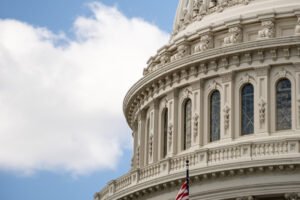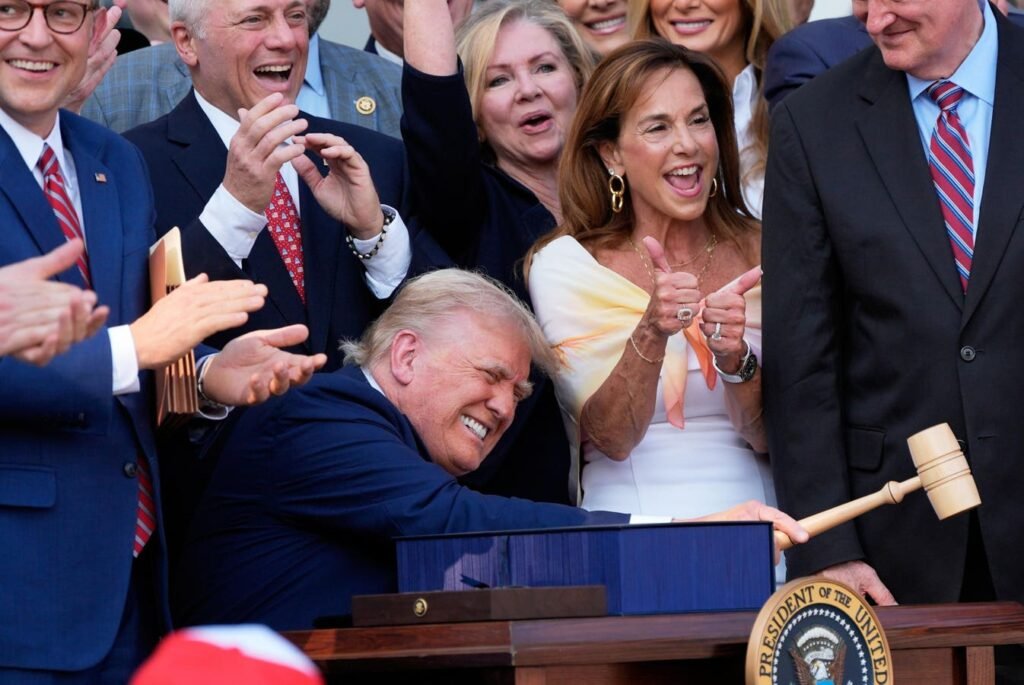The Department of Education clarified some key details on massive changes that are coming to federal student loan repayment as it advanced new regulations earlier this month. More than 40 million borrowers could be affected by the reforms.
The proposed regulations represent the next step in enacting the “One Big, Beautiful Bill Act” that President Donald Trump signed into law last summer. Congressional Republicans passed the legislation on a party-line vote. The bill directs the Department of Education to establish regulations that will facilitate the implementation major changes to various federal student loan programs.
The department convened a special rulemaking group called the Reimagining and Improving Student Education, or RISE, committee to review the proposed regulations. The RISE committee met earlier in October and discussed several key regulatory provisions that will fundamentally change federal student loan repayment for millions of Americans under the “One Big, Beautiful Bill Act.” Here’s a breakdown.
Changes To Fixed Federal Student Loan Repayment Plans
The “One Big, Beautiful Bill Act” makes significant changes to fixed federal student loan repayment plans, which are plans not tied to a borrower’s income. Currently, there is a 10-year Standard plan, a 25-year Extended plan, and a consolidation Standard plan of up to 30 years. Under these plans, monthly payments are fixed at the beginning of the student loan’s repayment term and don’t change over the course of repayment. There are also Graduated repayment plans, where monthly payments start off lower but then gradually increase over time on a fixed schedule.
Under the “One Big, Beautiful Bill Act,” these repayment plans will all be eliminated for borrowers who take out any new federal student loan, or consolidate existing loans, on or after July 1, 2026. After that, the only fixed repayment plan option will be a new tiered Standard repayment plan that has a term of 10 to 25 years, depending on the size of the loan balance.
The Department of Education confirmed during this month’s RISE committee meeting that borrowers who already have federal student loans and who do not take out new student loans or consolidate after the cutoff date will maintain access to the “legacy” fixed repayment options, regardless of when they actually enter repayment.
“Based on feedback from negotiators representing state officials, student loan servicers, and legal assistance organizations, ED clarified within the regulatory text that continued eligibility for standard, extended, and graduated is based on the date of loan disbursement, not the date at which a borrower enters repayment,” said The Institute for College Access and Success, or TICAS, in a blog post last week summarizing the RISE committee hearing. “During a non-binding pulse check used to gauge whether negotiators are close to consensus on proposed text, all negotiators gave language on fixed repayment plans a thumbs up, indicating the committee is likely to reach consensus on these provisions at the next meeting.”
If the committee reaches consensus on any topic, the Department of Education generally must accept the committee’s recommendation. Otherwise, without consensus, the department has more flexibility to implement its own interpretation of the statute.
Changes To Student Loan Income Driven Repayment Plans
The “One Big, Beautiful Bill Act” will also make substantial changes to income-driven repayment, or IDR, and these reforms will have profound and lasting effects. IDR plans allow borrowers to make payments based on a formula applied to their income and family size. Historically, these plans provided a path to student loan forgiveness, typically after 20 or 25 years in repayment. IDR plans are also typically a required component of Public Service Loan Forgiveness, or PSLF, which provides for loan forgiveness after 10 years in repayment while working in qualifying nonprofit or government employment.
Under the bill, three of the four existing IDR plans (ICR, PAYE, and SAVE) will be sunsetted by July 1, 2028. The IBR plan, which includes an older version and a newer, more affordable version for borrowers who first took out loans after July 1, 2014, will remain intact, with some modifications. The legislation also will create a new plan called the Repayment Assistance Plan, or RAP, in 2026. RAP may be more expensive for lower-income borrowers and for those who have been enrolled in SAVE or PAYE, and RAP also will have a 30-year repayment term before a borrower can qualify for student loan forgiveness, which is far longer than any existing IDR plan. But RAP also will have a principal and interest subsidy that will stop future balance growth, which is a unique benefit.
There will be a period of up to two years during which ICR, PAYE, SAVE, IBR, and RAP all coexist. But by July 2028, the only two remaining IDR plans will be IBR and RAP. Current borrowers in repayment would maintain eligibility for IBR, but if they take out any new student loans or consolidate on or after July 1, 2026, they would lose eligibility for IBR and would only be eligible for RAP.
In the RISE committee meeting earlier this month, the Department of Education clarified some key elements of the student loan repayment reforms for IDR plans that were not expressly clear from the statutory text of the “One Big, Beautiful Bill Act.” For example, he department confirmed that borrowers who select RAP will not necessarily be locked into that plan if they remain eligible for IBR; those borrowers will be able to switch back and forth between IBR and RAP.
“ED clarified that borrowers eligible for IBR may move freely between IBR and RAP even following the sunsetting of other ICR plans on July 1, 2028,” said TICAS in its blog post.
The Department of Education also clarified that for existing Parent PLUS borrowers to be grandfathered into IBR, they must first consolidate their loans before July 1, 2026, and enroll in the ICR plan before July 1, 2028. They must also make one payment under ICR before they can then switch to the more affordable IBR plan.
“ED interprets existing statute to require borrowers with eligible PLUS loans seeking to enroll in IBR before that deadline to first enroll in ICR, make one payment, and then enroll in IBR,” said TICAS. “In a pulse check on the IBR changes, all negotiators but the student loan servicer representative gave a thumbs up; the servicer negotiator gave a sideways thumb, indicating he needs more feedback from his constituency on how they would operationalize the proposed changes.”
Clarification On Student Loan Forgiveness
RISE committee negotiators also sought clarification on whether payments that were made under the REPAYE and SAVE plans, which are currently being challenged in court and appear likely to get struck down, will count toward student loan forgiveness under RAP.
“The negotiator representing legal assistance organizations shared concerns that ED’s proposed text did not explicitly state that payments made through the REPAYE and SAVE plans, which are currently enjoined in court, will count toward eventual forgiveness under RAP,” said TICAS in its blog post. “While ED confirmed that qualifying payments in the enjoined plans will count toward forgiveness, they remained firmly opposed to referring to REPAYE and SAVE in the regulation because of the possibility that the court may strike the plans down entirely.”
In response to these concerns, the Department of Education suggested removing references to specific repayment plans in the proposed regulations to help clarify that payments made under any IDR plans will count toward student loan forgiveness for RAP.
“Following an alternate proposal from the legal assistance and public institution negotiators, ED removed all references to existing plans from their proposal to clarify that qualifying payments on any income-driven plan prior to their sunsetting in 2028 will count toward forgiveness under RAP regardless of the court’s decision,” said TICAS.
However, some negotiators on the committee remain concerned about the lack of regulatory clarity. The issue will likely be revisited at the next RISE committee hearing.
Some Student Loan Borrowers Will Need To Switch Plans
The statutory text of the “One Big, Beautiful Bill” is not entirely clear what will happen to student loan borrowers who are enrolled in one of the plans that will be sunsetted by 2028. These include the ICR, PAYE, and SAVE plans.
The Department of Education’s proposed regulations indicate that these borrowers will need to affirmatively switch to either IBR or RAP, the only two IDR options that will be available after July 1, 2028. If they don’t apply to switch to one of those plans, these borrowers will instead be placed in the tiered Standard repayment plan.
“The proposal requires borrowers with Direct Loans disbursed before July 1, 2026, who are in repayment plans that will be phased out to transition to an eligible plan (IBR, RAP, or the standard plan) by July 1, 2028, or be automatically moved into the standard plan,” said TICAS in its summary. In addition, “Borrowers with loans disbursed on or after July 1, 2026, who do not select a plan will automatically be placed in the new tiered standard plan.”
What Comes Next For Student Loan Repayment Changes
The proposed regulations to implement the student loan repayment changes under the “One Big, Beautiful Bill Act” are not yet finalized. The conclusion of the first RISE committee hearing, and the tweaks made to the proposed regulatory text, represent the first major step in advancing the new rules. In a few weeks, the committee will hold a vote.
“The Department allowed negotiators to submit proposed amendments until October 10, 2025, and will circulate revised regulatory text to negotiators, likely in the week before the next session,” explained TICAS in its blog post. “The full committee will reconvene for its final work period on November 3-7, 2025, to further discuss these issues and vote on ED’s proposals.”
If RISE committee members reach consensus on the proposed changes to student loan repayment and loan forgiveness, then the Department of Education will finalize and enact those regulations. If there is disagreement among the committee members, the department will have a freer hand in establishing the new rules in accordance with its own interpretation of the statutory text.
Read the full article here












